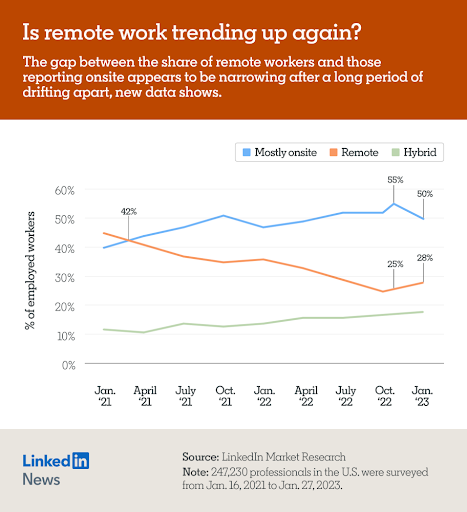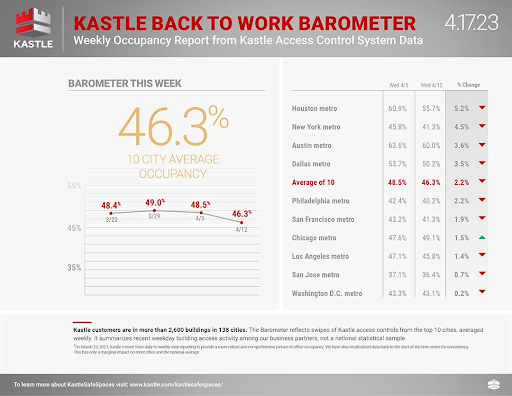
Despite the many CEOs throwing tantrums over return to office mandates, and the numerous headlines about large companies like JP Morgan Chase demanding full-time office work, the data doesn’t lie. And the data shows that we’ve seen a growth in remote work in recent weeks, according to the latest edition of LinkedIn’s Workforce Confidence Index, which surveyed 5,860 U.S. professionals.

Mostly onsite work has decreased from a high of 55% in November 2022 to 50% by January 2023, while remote work went from 25% to 28% in that time period, and hybrid increased from 16% to 18%. And similar data emerges from research by Stanford University’s Nicholas Bloom, who reported in March 2023 that in cities like New York, Chicago and Atlanta, more postings are open to remote workers than at any time in the past three years. In fact, office occupancy has decreased from over 50% compared to pre-pandemic levels in the beginning of 2023 to just 46% by mid-April 2023.

Leaders need to face the music: remote work, full time or part-time – what is known as hybrid – is here to stay. That’s what I tell the 5-10 leaders I speak to every week on the subject.
That means addressing the unique challenges associated with this new work modality can make or break a team’s success. Conflict resolution is one such challenge that, when mastered, can significantly boost your remote team’s performance and morale.
The Virtual Water Cooler: Fostering a Positive Environment
No amount of advanced technology can substitute the magic of in-person water cooler chats. But fear not, my fellow remote warriors! By creating a virtual water cooler environment, you can foster positivity and camaraderie in your remote team.
In one instance, a large financial services company faced significant communication breakdowns among its remote employees. The solution? Establishing a designated online space for casual conversations and team-building activities. This virtual gathering spot allowed team members to connect and build rapport, ultimately leading to improved conflict resolution.
Most of my clients who I helped adapt to the future of work, like the large financial services company mentioned above, implemented a “Morning Update” for four to eight-person teams within their company. Teams establish a separate channel for personal, non-work discussions using collaboration software, such as Microsoft Teams, Slack, Trello, or other similar tools.
Every morning, all team members send a message answering the following questions:
1) How are you doing overall?
2) How are you feeling right now?
3) What’s been interesting in your life recently outside of work?
4) What’s going on in your work: what’s going well, and what are some challenges?
5) What is one thing about you or the world that most other team members do not know about?
This activity provides an excellent foundation for developing relationships, rebuilding trust, and accommodating differences.
The Art of Active Listening: Be the Sherlock Holmes of Communication
Remote communication leaves ample room for misinterpretation. Active listening is your secret weapon in this battle. Train your team to be the Sherlock Holmes of communication: observing, analyzing, and empathizing with their counterparts.
A regional insurance company found success with this technique after experiencing a series of misunderstandings between remote team members. By implementing active listening training sessions, the company saw a significant decrease in conflicts and an increase in overall satisfaction.
Embrace the E.T. Approach: Empathy and Transparency
When it comes to remote conflict resolution, empathy and transparency are as vital as phoning home for E.T. Ensure your team members express their emotions and concerns openly while empathizing with their colleagues, which helps address bias and intolerance while improving relationships.
A mid-size IT company experienced a breakthrough in team dynamics when it adopted the E.T. approach. Managers encouraged employees to be open about their feelings and held regular check-ins to address any concerns. This practice not only resolved conflicts more efficiently but also strengthened team bonds.
Video Killed the Miscommunication Star: Leverage Video Calls for Clarity
Never underestimate the power of face-to-face communication—even in the virtual world. Video calls provide visual cues and help prevent miscommunication.
A professional services company of about 100 staff members found their conflict resolution dramatically improved after switching from text-based to video communication for team meetings. This simple yet effective change enabled employees to pick up on nonverbal cues and clarify any misunderstandings in real-time.
The Three Cs: Clarity, Consistency, and Constructive Feedback
Imagine trying to assemble a jigsaw puzzle with ambiguous instructions and inconsistent feedback. That’s how remote teams feel when they lack the three Cs: clarity, consistency, and constructive feedback.
A late-stage SaaS startup overcame a major communication hurdle by incorporating the three Cs into their workflow. Managers provided clear instructions, maintained consistent communication channels, and offered constructive feedback. The result? A highly motivated and conflict-free team.
The Power of the (Virtual) Huddle: Regular Team Check-Ins
In remote work, out of sight shouldn’t mean out of mind. Regular team check-ins are essential for addressing potential conflicts before they escalate.
The largest law firm in a Midwestern city saw a marked improvement in team dynamics after implementing weekly check-ins. This practice provided a platform for employees to raise concerns and resolve conflicts proactively.
Cultural Intelligence: Embracing Diversity for Conflict Resolution
With remote work comes the opportunity to build a team from a diverse pool of talent. While this diversity can be an incredible asset, it also presents unique challenges in conflict resolution. Developing cultural intelligence is the key to unlocking the full potential of your global remote team.
A direct-to-consumer e-commerce company of about 200 staff decided to hire talent around the globe after going remote during the pandemic, finding this modality worked well for them, and committing to maintaining a remote-first culture after the end of the pandemic. However, what it failed to realize was that by hiring globally, it would face cultural clashes within its remote workforce, causing conflicts to escalate. By implementing cultural intelligence training and encouraging employees to learn about their colleagues’ backgrounds and customs, the company was able to transform potential conflicts into opportunities for growth and collaboration.
Peer-to-Peer Mediation: Empowering Your Team to Resolve Conflicts
One of the most effective ways to handle remote conflict resolution is by empowering your team to resolve conflicts among themselves. Peer-to-peer mediation can foster a sense of ownership and responsibility within the team, leading to stronger connections and better conflict management.
A prominent healthcare organization faced escalating tensions among remote team members. By implementing a peer-to-peer mediation program, the organization was able to address conflicts more proactively and efficiently, allowing team members to feel heard and respected.
Flexibility: The Remote Workforce’s Superpower
Finally, in a world where change is the only constant, flexibility is the superhero cape every remote team needs. Being adaptable to new situations, technologies, and communication styles can make a world of difference in conflict resolution.
A multinational tech company faced an uphill battle with conflicts arising from different time zones and communication preferences. By encouraging flexibility and adopting asynchronous communication tools, the company witnessed a significant reduction in misunderstandings and an overall improvement in team cohesion.
The Path to Remote Conflict Resolution Mastery
Remote work – part-time or full-time – is an inevitable part of the future, no matter how much the Jamie Dimons of the world want to get back to full-time in-office work. That means leaders need to learn new methods for managing in a hybrid world. Doing so comes with its unique set of challenges, but with the right strategies and tools, conflict resolution can be mastered. By embracing advanced techniques outlined above, you can help your remote team thrive and navigate the remote work landscape like seasoned pros. Remember that the key to success lies in your commitment to creating an inclusive, supportive, and open environment where conflicts are viewed as opportunities for growth and improvement. By empowering your remote team to communicate effectively, embrace diversity, and resolve conflicts proactively, you will not only enhance team performance and morale but also set the stage for long-term success in the remote work arena.
Key Take-Away
Embracing remote work as a permanent part of the future requires addressing challenges like conflict resolution through fostering a positive virtual environment and open communication… >Click to tweet
Image Credits: Marcus Aurelius
Dr. Gleb Tsipursky was lauded as “Office Whisperer” and “Hybrid Expert” by The New York Times for helping leaders use hybrid work to improve retention and productivity while cutting costs. He serves as the CEO of the boutique future-of-work consultancy Disaster Avoidance Experts. Dr. Gleb wrote the first book on returning to the office and leading hybrid teams after the pandemic, his best-seller Returning to the Office and Leading Hybrid and Remote Teams: A Manual on Benchmarking to Best Practices for Competitive Advantage (Intentional Insights, 2021). He authored seven books in total, and is best know for his global bestseller, Never Go With Your Gut: How Pioneering Leaders Make the Best Decisions and Avoid Business Disasters (Career Press, 2019). His cutting-edge thought leadership was featured in over 650 articles and 550 interviews in Harvard Business Review, Forbes, Inc. Magazine, USA Today, CBS News, Fox News, Time, Business Insider, Fortune, and elsewhere. His writing was translated into Chinese, Korean, German, Russian, Polish, Spanish, French, and other languages. His expertise comes from over 20 years of consulting, coaching, and speaking and training for Fortune 500 companies from Aflac to Xerox. It also comes from over 15 years in academia as a behavioral scientist, with 8 years as a lecturer at UNC-Chapel Hill and 7 years as a professor at Ohio State. A proud Ukrainian American, Dr. Gleb lives in Columbus, Ohio. In his free time, he makes sure to spend abundant quality time with his wife to avoid his personal life turning into a disaster. Contact him at Gleb[at]DisasterAvoidanceExperts[dot]com, follow him on LinkedIn @dr-gleb-tsipursky, Twitter @gleb_tsipursky, Instagram @dr_gleb_tsipursky, Facebook @DrGlebTsipursky, Medium @dr_gleb_tsipursky, YouTube, and RSS, and get a free copy of the Assessment on Dangerous Judgment Errors in the Workplace by signing up for the free Wise Decision Maker Course at https://disasteravoidanceexperts.com/newsletter/.




